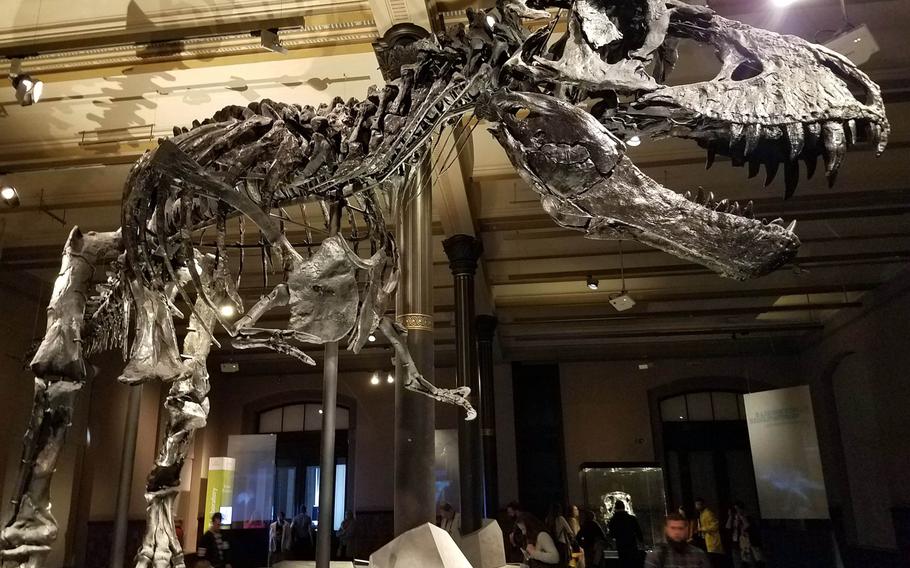
The Tyrannosaurus rex skeleton in the dinosaur exhibit at the Museum of Natural History in Berlin is one of the most complete in the world. (Martin Egnash)
Germany’s hip, modern capital is as well known for its all-night parties as it is for historical symbols like the Brandenburg Gate, Berlin Wall and Checkpoint Charlie. But unbeknownst to many, the city is also home to one of the greatest natural history museums in the world, the Museum fuer Naturkunde.
If you’re like me, you’ll end up spending an embarrassingly long time in this museum, discovering collections that include a gallery of animals preserved in jars and an exhibit featuring the largest mounted dinosaur skeleton in the world.
The dinosaurs are the highlight of the museum, if you ask me. Three enormous dino skeletons stand tall in their exhibit area in the heart of the sprawling museum complex. In the center of the trio is the skeleton of a 45-foot-tall Giraffatitan, once thought to be a second species of the Brachiosaurus genus.
The Giraffatitan is massive on every dimension. Even its forelegs look bigger than my first car. The museum made a replica of the dinosaur’s skull and put it at ground level so you can see what it looks like, because you can’t see the details so high up.
The museum is also home to one of the most complete Tyrannosaurus rex skeletons in the world and a “missing link” fossil that looks like a ferocious chicken.
Although kids tend to love dinosaurs, the museum has posted a disclaimer warning that “realistic animated films with hunting scenes among dinosaurs ... which might terrify children” are screened in the exhibit area.
After you finish ogling the dinosaurs, head to the hall of mineral specimens, which includes fancy crystals and gnarly colored rocks. The coolest is probably the moon rock brought back from the last manned trip there.
Among the preserved animals on display in another room is Germany’s much-loved Knut the polar bear, who was reared by zookeepers at Berlin’s zoo after his mother abandoned him. Knut died in 2011 at the age of 4 to the sorrow of fans around the world.
Another room, filled with jars of dead animals, is as fascinating as it is gross. Look for the snake that choked on a lizard among the animals floating in jars. It’s sick.
Dozens of meteorites and models of planets and stars feature in several exhibits about space, while man’s impact on the environment is the focus of another exhibit. The museum’s displays about climate change, pollution and modern farming are a lot less fun than the dinosaur ones, but you should probably see them anyway.
egnash.martin@stripes.com Twitter: @Marty_Stripes
DIRECTIONS: Address: Invalidenstrasse 43, 10115 Berlin; There is a tram stop right by the museum. Get off at the Museum fuer Naturkunde stop.
TIMES: 9:30 am to 6 p.m., 10 a.m. to 6 p.m. weekends, closed on Mondays
COSTS: Adult entry is 8 euros ($8.81), students and children ages six to 15 are 5 euros. Ages five and under get in free.
FOOD: The museum’s cafe offers light lunch items such as soups and sandwiches, as well as sweet baked goods and hot and cold drinks.
INFORMATION: Online: museumfuernaturkunde.berlin/en